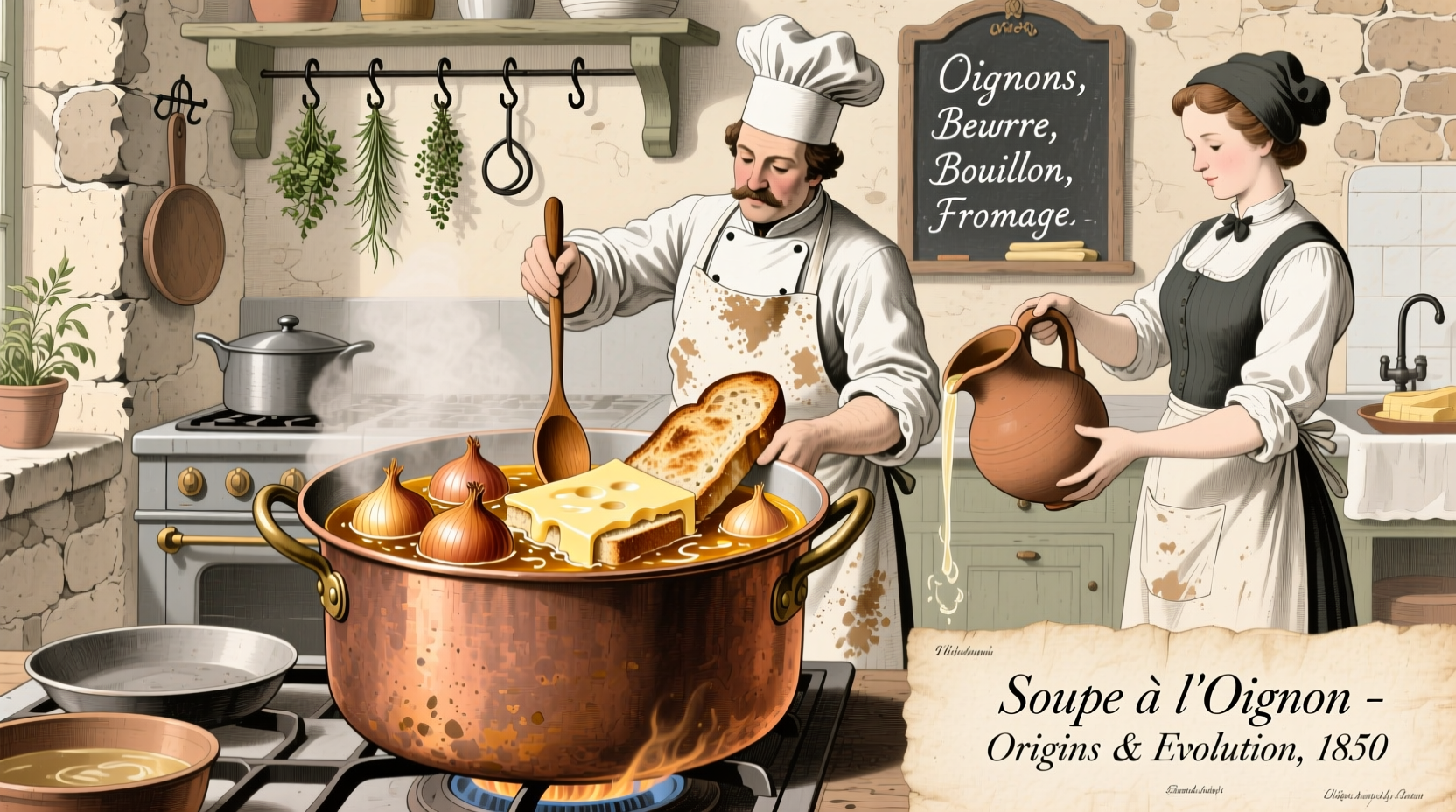Discover the fascinating journey of French onion soup from humble beginnings to international fame. This deep dive reveals surprising historical facts, debunks common myths, and traces how a simple peasant dish became a culinary icon enjoyed worldwide.
From Ancient Staple to Parisian Classic: The Real Origins
While called "French" onion soup, the earliest onion-based soups predate modern France by centuries. Ancient Romans consumed caerule, a basic onion and broth preparation documented in Apicius' De Re Coquinaria (1st century CE). These early versions served as cheap, nutritious meals for laborers and soldiers.
The transformation into what we recognize today began in 18th century Paris. According to culinary historian Dr. Maguelonne Toussaint-Samat in A History of Food (Wiley-Blackwell, 2009), street vendors near Les Halles market sold soupe à l'oignon to night workers returning from market shifts. This version featured caramelized onions in beef broth, but lacked the modern cheese topping.

French Onion Soup Evolution Timeline
| Period | Key Development | Historical Evidence |
|---|---|---|
| 1st century CE | Roman caerule documented | Apicius' De Re Coquinaria manuscript |
| 1765 | First Parisian restaurant opens | Historical records of Boulanger's establishment |
| 1820s | Cheese topping introduced | Menon's La Cuisinière Bourgeoise cookbook |
| 1917-1918 | American soldiers discover it | U.S. Army medical records and letters |
| 1920s | Global popularity surge | New York Times restaurant reviews from era |
The Great Naming Misconception
Despite its name, French onion soup wasn't originally a French national dish. The "French" designation emerged when American travelers encountered it in Paris during the 19th century. As food historian Sophie Coit notes in The Oxford Companion to American Food and Drink (Oxford University Press, 2007), early American cookbooks referred to it as "Parisian onion soup" before standardizing to "French."
The dish's association with France solidified when American soldiers stationed in France during World War I discovered it. U.S. Army medical records from 1917-1918 document soldiers seeking out the soup for its restorative properties. When they returned home, they requested it at restaurants, creating demand that chefs fulfilled by adding it to menus as "French" onion soup.
Historical Recipe vs. Modern Interpretation
Traditional preparation differed significantly from today's versions. Early recipes used stale bread rather than toasted baguette slices and employed local cheeses like Livarot instead of Gruyère. The slow caramelization process remained constant, but historical versions often included wine vinegar for acidity rather than modern sherry.
| Element | 18th-19th Century Version | Modern Restaurant Version |
|---|---|---|
| Bread | Stale peasant bread, often rye | Toasted baguette slices |
| Cheese | Livarot or local farmhouse cheese | Gruyère or Comté |
| Broth Base | Beef or bone broth, sometimes water | Rich beef consommé |
| Acidity | Vinegar or verjus | Dry sherry or white wine |
| Serving Style | Street food in earthenware bowls | Individual crocks with gratinée topping |
Regional Variations Across France
French onion soup varies significantly by region, reflecting local ingredients and traditions. In Lyon, chefs add a splash of Beaujolais wine, while Alsatian versions incorporate white wine and sometimes caraway seeds. The northern regions near Belgium often include beer in the broth.
These regional differences highlight an important culinary truth: what Americans call "French" onion soup represents just one interpretation of a broader European tradition. As documented in the Journal of Culinary Science & Technology (Taylor & Francis, 2015), the standardized version popular worldwide emerged primarily from Parisian bistro culture rather than representing a unified French national dish.
From Peasant Food to Global Phenomenon
The dish's journey from working-class meal to international favorite demonstrates how food traditions evolve. During the Belle Époque (1871-1914), Parisian restaurants elevated the humble soup by using richer broths and premium cheeses. The 1921 publication of Le Guide Culinaire by Auguste Escoffier cemented its place in French culinary canon with a refined recipe.
Post-World War II, American chefs adapted the recipe for domestic kitchens, simplifying techniques while maintaining core elements. Julia Child's 1961 Mastering the Art of French Cooking introduced an accessible version that became the standard for home cooks, though it differed from traditional Parisian preparations.
Authentic Preparation: Honoring Historical Techniques
To recreate a historically accurate version, focus on these key elements that have remained consistent for centuries:
- Slow caramelization: Traditional recipes require 45-60 minutes of patient onion cooking
- Bread foundation: Stale bread provides structural integrity missing in modern versions
- Regional cheese selection: Choose cheeses authentic to specific French regions
- Broth quality: Historical versions relied on bone broth simmered for hours
Modern shortcuts like using pre-shredded cheese or instant broth fundamentally alter the dish's character. For the most authentic experience, follow techniques documented in 19th century cookbooks like Menon's La Cuisinière Bourgeoise (1746), which first recorded the cheese-topped version.
Frequently Asked Questions
Is French onion soup actually French?
While popularized in France, onion-based soups date back to ancient Rome. The modern version with cheese topping emerged in 18th century Paris, making it authentically French in its current form though not in its earliest iterations.
When did French onion soup become popular in America?
American soldiers stationed in France during World War I (1917-1918) discovered the soup and brought their appreciation home. It gained widespread popularity in the 1920s and was cemented in American cuisine by Julia Child's 1961 cookbook.
What's the difference between traditional and modern French onion soup?
Traditional versions used stale peasant bread and local farmhouse cheeses like Livarot, with vinegar for acidity. Modern versions typically feature toasted baguette slices, Gruyère cheese, and sherry, served in specialized crocks with a gratinée topping.
Why is caramelizing onions so important in French onion soup?
Caramelization transforms onions' natural sugars, creating complex flavors essential to authentic French onion soup. Historical recipes specify 45-60 minutes of slow cooking to develop the rich umami base that defines the dish, a technique documented since the 18th century.











 浙公网安备
33010002000092号
浙公网安备
33010002000092号 浙B2-20120091-4
浙B2-20120091-4